Grazing pastures might not be what comes to mind when you think about pollinator-friendly habitat. After all, our agriculture system is a major driver of the dramatic loss of biodiversity, especially for invertebrates. However, farmers and farmlands are also one of the integral solutions to this crisis. Over the past year, I have been working with a farm in Wisconsin to understand how even small changes to their practices can make a positive impact for conservation!
Farmers can support pollinators by incorporating native prairies into their pastures
Farmer Ryan Heinen of Gwenyn Hill Farm is combining habitat restoration practices with conservation-minded agriculture. He cares for 80 organic dairy and 15 beef cows, and has worked hard to try something different: planting native prairie for his cows to graze.

Contrary to the idea that conservation is achieved through “hands-off” management, the health of our prairies, woodlands, and wetlands have always and continue to rely upon natural disturbances. Many ecosystems in North America evolved with and benefit from grazing by large mammals (caribou, elk, bison, and deer), fire, and even flooding. And, human stewardship is of equal importance for ecosystems’ health, as demonstrated by the well-documented history of cultivation and care by indigenous peoples.
With these relationships as a blueprint and motivated by his strong conservation ethic, Ryan has taken 11 acres of his pastures, previously consisting of introduced grass and clover species, and replaced them with native prairie. The new planted prairie pasture is much more diverse, with more than 30 native plant species adding substantial habitat for pollinators and other wildlife. That is quite a significant addition when compared to the 7 species of introduced grasses and flowers that make up the surrounding 200 acres of pasture.
To sustain the prairie plant community, Ryan has also changed how he grazes his herd. Cows graze the prairie less often, in less dense groups, and are prevented from grazing part of the prairie pasture - leaving that section for wildlife. Ryan rotates the cows through the prairie pastures once or twice a summer, first in late June through early July, and (for some paddocks) again about 55 days later. He keeps the cows from grazing any one section of prairie for too long, moving them every 24 to 48 hours from one prairie paddock to another. These changes allow the prairie to sufficiently grow back after grazing, and ensure that there are always some prairie plants available for pollinators and other wildlife to use.

Even small changes in pasture land can make a big difference for pollinators
In Wisconsin, Ryan’s prairie grazing work is unique. Thanks to the help of a Farmer/Rancher North Central Sustainable Agriculture Research and Education grant, he and I had the opportunity to collect data on his prairie grazing work. Through the summer of 2023, Ryan collected weekly forage samples of native grasses from his prairie pasture to track nutritional quality for his cows. I worked hard to inventory the prairie pasture plant community, track floral blooms, survey native bees, and (with the help of Rae Olson, an undergraduate from University of Wisconsin-Parkside) count butterflies. Our goal was to explore how well planted prairie pastures can support plants, pollinators, cows, and people.
Here is some of what we observed:
- The nutritional value of native prairie plants peaked in late June and was comparable to that of the introduced grass pastures at that time.
- Cows preferentially grazed the prairie grasses and nibbled on the flowers, too. Some species of prairie flowers handled the grazing very well and continued to bloom.
- Twenty different butterfly species visited the prairie pasture through the growing season. Monarchs, pearl crescents, and eastern tiger swallowtails were especially frequent.
- Before and after grazing, native bees were common visitors to the varied native blooms of purple prairie clover, bergamot, yellow coneflower, ox-eye sunflower, stiff goldenrod, golden alexander, yarrow, purple coneflower, and butterfly milkweed.
- When both introduced and native flowers were present in the same pasture, native bee species overwhelmingly (92% of the time) preferred the native flowers!
In my opinion, what we learned emphasizes the outsize importance native, planted prairie pastures can play in sustaining pollinator life on our farms while providing nutritional forage for cows. While other pastures may seem abundant with blooms of alfalfa and clover, these plants actually do not support many types of native bees. Only a few bee genera, sometimes just a few species, will actually visit these flowers to access their pollen or nectar.

Agriculture and conservation can coexist
In states like Wisconsin where prairie has nearly been erased from the landscape, converting or adding even a few acres of planted prairie into a grazing system may make all the difference in pollinator conservation! These small prairie pastures can be crucial in “knitting” together patches of habitat spread across the wider landscape. The Xerces Society is proud to be a leader in implementing thoughtful conservation practices that benefit pollinators, support farmers, and nourish us in so many ways.
As a farmer is able – considering their land limitations, farm layout, and conservation ethic – adding native prairie pasture can only reinforce the foundational connections between plants, pollinators, farm animals, people, and wildlife. And, as an eater, I know who I’ll be looking to buy my food from – Ryan Heinen and farmers like him.





